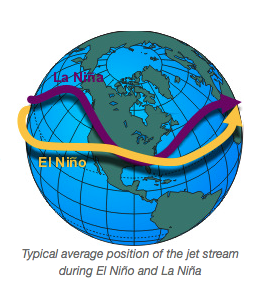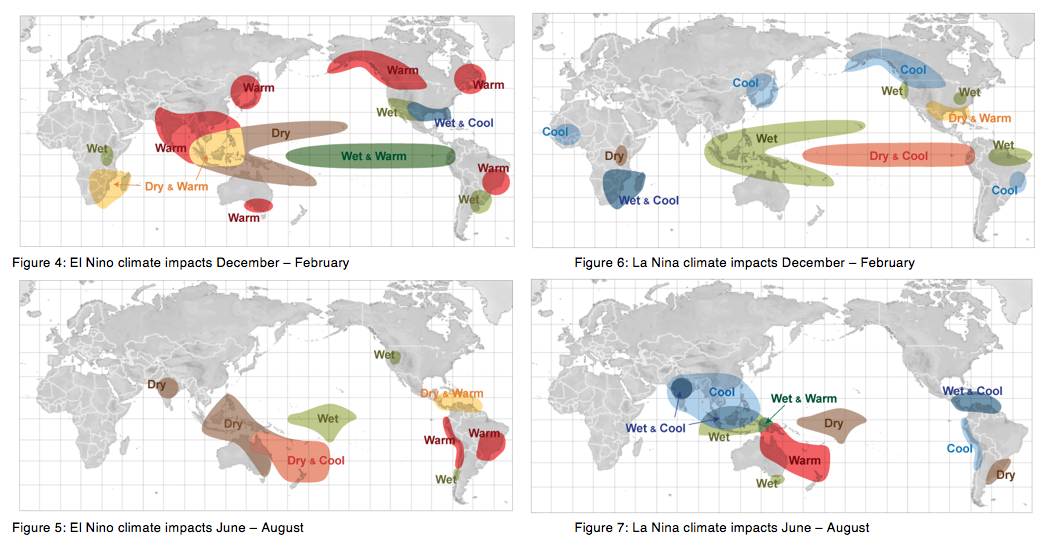ENSO Teleconnections
Author: Ennia Bosshard
El Niño and the Southern Oscillation, also known as ENSO, is a periodic fluctuation in sea surface temperature (El Niño) and the air pressure of the overlying atmosphere (Southern Oscillation) across the equatorial Pacific Ocean. As it influences the Walker Circulation and the Jet Stream, it affects the climate over many regions of the Earth, including regions that are remote from the tropical Pacific Ocean.
Particularly extreme El Nino and La Nina events, which lead to massive reorganizations of the atmospheric convection, affect ecosystems, agriculture, tropical cyclones, droughts, floods and other extreme weather events worldwide. This is why we call it the ENSO teleconnection, referring to climate anomalies being related to each other at large distances, typically thousands of kilometers.

Extreme EN events
The ENSO teleconnections were better investigated because of the extreme El Nino events in 1982/83 and 1997/98. The sea surface temperature anomalies caused an equatorward shift of the intertropical convergence zone and disrupted weather pattern globally. The anomalies led to environmental disturbances and extended to all continents. Catastrophic effects and damages led to more investigation in the 1980s to understand and detect the teleconnection.
Impacts on the Jet Stream
El Nino leads to an increasing sea surface temperature (SST) of the central and eastern tropical Pacific Ocean. The increased temperature and moisture in the air right above the water results in more convection and thunderstorm activity than usual. This additional heat sets in motion yet another series of important effects.
As the position of the warm water along the equator shifts back and forth across the Pacific Ocean, the position where the greatest evaporation of water into the atmosphere occurs, also shifts with it. This has a profound effect on the average position of the jet stream which, in turn, effects the storm track. This change of position can have a huge impact on the type of weather in North America and in regions that are much further away.
Figure 3: Typical average position of the jet stream during El Nino and La Nina (http://www.srh.noaa.gov/jetstream/tropics/enso_impacts.html)
Global importance of ENSO
The figures below show what changes and during which seasons El Nino and La Nina are expected to cause. The coloured areas show significant changes from normal weather. The stronger El Nino or La Nina, the more likely and intense are the teleconnection side effects.
ENSO leads to excess rain in southern U.S. and parts of eastern South America, whereas it causes drought and warm weather in Southeast Asia and eastern South Africa in winter. In the months from June - August, the ENSO teleconnection causes drought in Indonesia, Australia and Central America. The effects of La Nina are mostly converse.

(All figures http://www.srh.noaa.gov/jetstream/tropics/enso_impacts.html)
Cyclone Activity
The ENSO influence the cyclone activity in the North Atlantic. Moderate to strong El Ninos lead to a substantial reduction in cyclone numbers and hurricane days, and an overall reduction in intensity. This significant change is believed to be due to stronger than normal westerly winds that develop in the western North Atlantic and Caribbean region during El Niño years. Other regions around the world are only slightly affected.
Outlook: ENSO and climate change
Historical data show that the ENSO variation is most likely linked to global climate change. Studies (Cai et al., 2014) show that global warming leads to a significant increase in the frequency of the El Nino and La Nina events, and especially the El Nino phases become more intense. The amplitude of the ENSO variability in the observed data of the last 50 years still increases which is thought to be caused by global warming.
References
- Tony Barnston, 2014. How ENSO Leads to a Cascade of Global Impacts. International Research Institute for Climate and Society. http://iri.columbia.edu/news/how-enso-leads-to-a-cascade-of-global-impacts/
- National Weather Service NOAA. Weather Impacts of ENSO. http://www.srh.noaa.gov/jetstream/tropics/enso_impacts.html
- National Weather Service NOOA. El Nino/Southern Oscillation Technical Discussion. https://www.ncdc.noaa.gov/teleconnections/enso/enso-tech.php
- Wikipedia. El Nino-Southern Oscillation https://de.wikipedia.org/wiki/El_Niño-Southern_Oscillation
- Cai et al., 2014. Increasing frequency of extreme El Nino events due to greenhouse warming. Nature. http://www.nature.com/nclimate/journal/v4/n2/full/nclimate2100.html
- Wikipedia. Teleconnections. https://en.wikipedia.org/wiki/Teleconnection